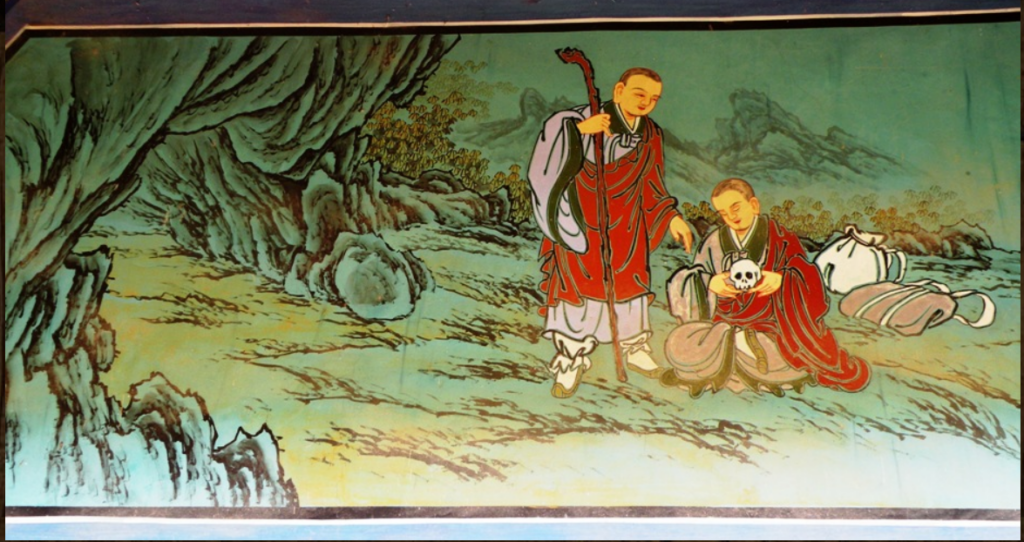The Pali Canon or Pali Tipitika is the scriptural canon of Theravada Buddhism. Mahayana Buddhism has two canons, called the Tibetan Canon and the Chinese Canon. The Chinese Canon is the collection of texts considered authoritative by most schools of Mahayana Buddhism other than Tibetan. It’s called the “Chinese Canon” because most of the texts were preserved in Chinese. It is the chief scriptural canon of Korean, Japanese and Vietnamese Buddhism as well as Chinese Buddhism.
There is some overlap among these three major canons, but most Buddhist scriptures are only included in one or two of them, not all three. Even within the Chinese Canon a sutra venerated by one school of Mahayana may be ignored by others.
The schools of Mahayana that do more or less acknowledge the Chinese canon usually work with only part of it, not the whole thing. Unlike the Pali and Tibetan Canons, which have been formally adopted by their traditions, the Chinese Canon is only loosely canonical.
Very basically, the Chinese Mahayana Canon primarily consists of (but is not necessarily limited to) several collections of Mahayana sutras, the Dharmaguptaka Vinaya, the Sarvastivada Abhidharma, the Agamas, and commentaries written by prominent teachers sometimes referred to as the “sastras” or “shastras.”.
Mahayana Sutras
The Mahayana sutras are a large number of scriptures mostly written between the 1st century BCE and the 5th century CE, although a few may have been written as late as the 7th century CE. Most are said to have originally been written in Sanskrit, but very often the original Sanskrit has been lost, and the oldest version we have today is a Chinese translation.
The Mahayana sutras are arguably the largest and most important part of the Chinese Canon. For more about the many sutras found in the Chinese Canon, please see “Chinese Mahayana Sutras: An Overview of Buddhist Sutras of the Chinese Canon.”
The Agamas
The Agamas might be thought of as an alternative Sutta-pitaka. The Pali Sutta-pitaka of the Pali Canon (Sutra-pitaka in Sanskrit) is the collection of the historical Buddha’s sermons that was memorized and chanted in the Pali language and finally written down in the 1st century BCE.
But while that was going on, elsewhere in Asia the sermons were being memorized and chanted in other languages, including Sanskrit. There probably were several Sanskrit chanting lineages, in fact. The Agamas are what we have of those, mostly pieced together from early Chinese translations.
Corresponding sermons from the Agamas and Pali Canon are often similar but never identical. Exactly which version is older or more accurate is a matter of opinion, although the Pali versions are far better known.
The Dharmaguptaka Vinaya
The Sutra-pitaka, Vinaya-pitaka and Abhidharma-pitaka together make up a collection called the Tripitaka, or Tipitaka in Pali. The Vinaya-pitaka contains the rules for the monastic orders established by the historical Buddha, and like the Sutra-pitaka it was was memorized and chanted. Today there are several existing versions of the Vinaya. One is the Pali Vinaya, followed in Theravada Buddhism. Two others are called the Mulasarvastivada Vinaya and the Dharmaguptaka Vinaya, after the early schools of Buddhism in which they were preserved.
Tibetan Buddhism generally follows the Mulasarvastivada and the rest of Mahayana generally follows the Dharmaguptaka. There may be exceptions, however, and sometimes the Mulasarvastivada Vinaya is considered part of the Chinese Canon also. Although the Dharmaguptaka has slightly fewer rules, overall the differences between the two Mahayana Vinayas are not radically significant.
The Sarvastivada Abhidharma
The Abhidharma is a large collection of texts that analyze the Buddha’s teachings. Although attributed to the Buddha, actual composition probably began a couple of centuries after his Parinirvana. Like the Sutra-pitaka and the Vinaya-pitaka, the Abhidharma texts were preserved in separate traditions, and at one time there probably were many different versions.
There are two surviving complete Abhidharmas, which are the Pali Abhidhamma, associated with Theravada Buddhism, and the Sarvastivada Abhidharma, which is associated with Mahayana Buddhism. Fragments of other Abhidharmas also are preserved in the Chinese Canon.
Strictly speaking, the Sarvastivada Abhidharma is not precisely a Mahayana text. The Sarvastivadins, who preserved this version, were an early school of Buddhism more closely aligned with Theravada than with Mahayana Buddhism. However, in some ways it represents a transitory point in Buddhist history in which Mahayana was taking shape.
The two versions are considerably different. Both Abhidharmas discuss the natural processes that connect mental and physical phenomena. Both works analyze phenomena by breaking them down into momentary events that cease to exist as soon as they occur. Beyond that, however, the two texts presents different understandings of the nature of time and matter.
Commentaries and Other Texts
There are vast numbers of commentaries and treatises written by Mahayana scholars and sages over the centuries that also are included in the Chinese Canon. Some of these are called “sastras” or “shastras,” which in this context designates a commentary on a sutra.
Other examples of commentaries would be texts such as Nagarjuna‘s Mulamadhyamakakarika, or “Fundamental Verses of the Middle Way,” which expounds Madhyamika philosophy. Another is Shantideva’s Bodhicaryavatara, “Guide to the Bodhisattva’s Way of Life.” There are many large collections of commentaries.
The list of what texts may be included is, shall we say, fluid. The few published editions of the canon are not identical; some have included non-Buddhist religious texts and folk tales.
This overview is barely an introduction. The Chinese Canon is a vast treasure of religious / philosophical literature.
